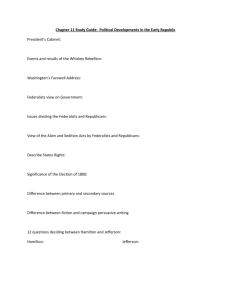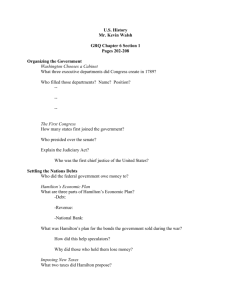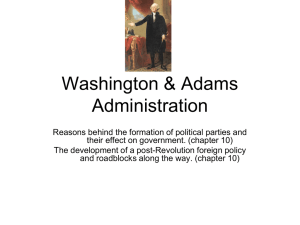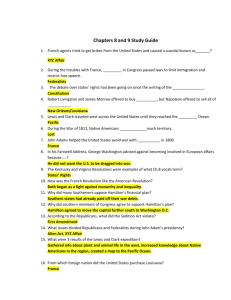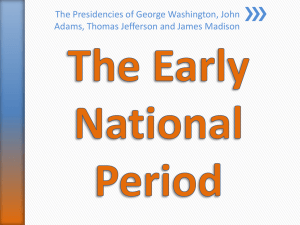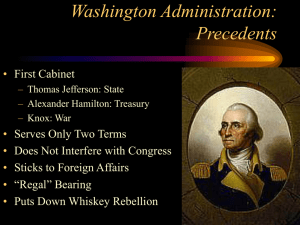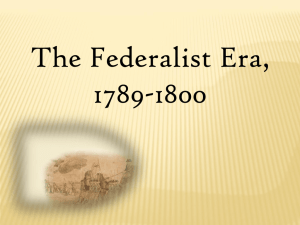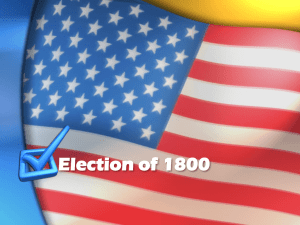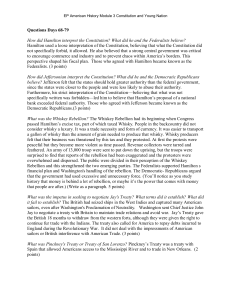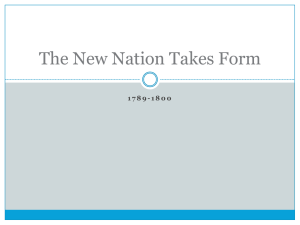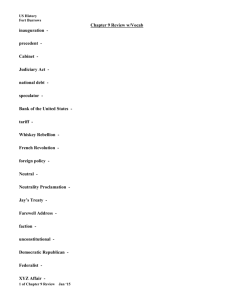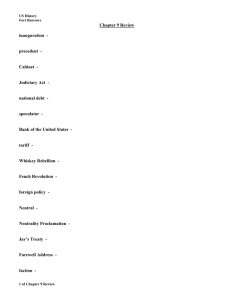Chapter 11 - wfbmsushistory8
advertisement
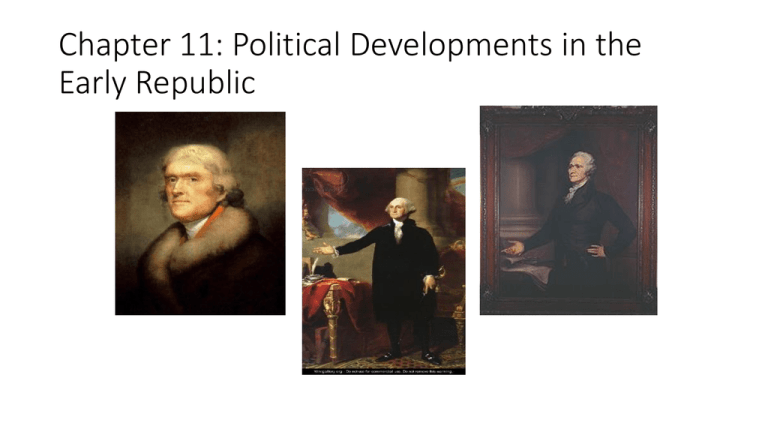
Chapter 11: Political Developments in the Early Republic The Federal Judiciary Act 1. Set up the federal court system 2. Appointed 5 justices and 1 chief justice to the Court 3. John Jay was the 1st chief justice 4. John Jay was a lawyer and negotiated the US Supreme Treaty of Paris Washington’s Cabinet 1. Secretary of State: Thomas Jefferson • Handled relations between the US and other 2. Secretary of War: Henry Knox • Trusted general during the Revolutionary War 3. Secretary of Treasury: Alexander Hamilton • Raised money and handled government finances 4. Attorney General: Edmund Randolph • Chief legal advisor to the President countries The Whiskey Rebellion • Farmers in western Pennsylvania didn’t like paying taxes • Turned grain into whiskey because it was cheaper to transport • Washington and 13,000 state militia went to PA to squash the rebellion • GW proved the Federal government would not put up with such rebellions The French Revolution • French people rebelled against their king. • Many Americans liked/supported this idea. • Jefferson and his followers began calling themselves the DemocraticRepublicans or Republicans • Hamilton and his followers didn’t like the French rebellion and began calling themselves Federalists Washington’s Farewell Address • Growing tension between Federalists and DemocraticRepublicans caused GW to serve a 2nd term • Urged people to remember why they fought for independence • Warned people of the danger of political parties • Worried about getting involved in foreign affairs Economic Problems of the US 1. The government needed MONEY! • Taxes? • Tariffs? • How to get the money? 2. The government needed to pay back its debts • Owed money to France, Netherlands, Spain, and other individuals---52 million dollars • Individual states borrowed money--- 25 million dollars =77 million dollars in debt In today’s value of a dollar, that would be equal to $1,038,942,591 Hamilton’s Financial Plan 1. Hamilton believed in a strong federal government that encouraged business and industry 2. Hamilton had little faith in ordinary citizens 3. Hamilton’s 3 Part Plan A. Pay off the war debt B. Raise government revenue C. National bank Hamilton’s 3 Part Plan 1. Pay off the war debt • Problem with the northern states that still owed money • Compromise reached: southern states agreed to help pay the northern states’ debt if the US capital was placed in the South. 2. Raise government revenue (money) • Tariff- tax on foreign goods which encouraged Americans to buy US made goods 3. National Bank • Safe place to keep money • Could issue paper money • Could make loans to the government and the people Views of the Constitution Loose vs. Strict Construction 1. Loose Construction • Supported by Alexander Hamilton (Federalist party) • Believed that money was more valuable than land • Believed they could do whatever the Constitution did not prohibit them from doing • The Constitution doesn’t not say they couldn’t make a National Bank, so they could do it Loose Construction vs. Strict Construction 2. Strict Construction • Supported by Thomas Jefferson and James Madison (Democrat-Republican party) • Believed land was more valuable than money • Believed people only had the power to do what the Constitution says they can do • Constitution doesn’t say anything about a National Bank, so there can’t be one • Feared banks would create money and power hungry men 11.6 John Adams’ Presidency • John Adams, Federalist, is President • Thomas Jefferson, Democratic-Republican, Vice President • This is problem! Alien and Sedition Acts • Federalists passed these laws to protect the US from foreigners who might be a threat. • Alien Act • Lengthened the time aliens could become citizens • 5 to 14 years in US • Sedition Act • Speaking or printing unfavorable things about the government (Federalists) could land you in jail • Lengthened the time aliens could become citizens • 5 to 14 years in US Made to keep the Federalists in power! Virginia and Kentucky Resolutions • An attempt for states to protest the Alien and Sedition Acts • Didn’t work • But did begin talk about States’ Rights Theory 11.7 and 11.8 The Election of 1800 • Jefferson and Burr (Dem-Rep) vs. Adams and Pinckney (Fed) • People wanted Hamilton to be President but he was born in the Caribbean and was not eligible • Jefferson = 73 votes • Burr = 73 votes • Adams = 65 Resolution and the 12th Amendment • Hamilton persuaded Congressmen to vote for Jefferson over Burr…what??? I thought they hated each other! • Jefferson won the election • Burr kills Hamilton in a dual…really??? • 12th Amendment changed things so a tie couldn’t happen again Chapter 11 Reading Check 1. Who was in Washington’s cabinet? 2. What was learned by the Whiskey Rebellion? 3. What did GW warn in his farewell address? 4. Explain the difference between a loose and strict constructionist. 5. How did the Alien and Sedition Acts keep the Federalists in power? 6. What problem did the 12th Amendment resolve?
